A study confirmed that people have difficulty judging how much food they eat. This can pose a problem since excessive amounts of food are frequently available to us.
Ideally, our internal hunger signals would guide us to eat just the right amount of food for our needs. Unfortunately, studies show that external influences distract many of us from following our body signals.
A larger serving bowl is one external influence that causes people to eat more. Studies in the Food and Brand Laboratory at the University of Illinois show that people eat more candy out of a larger candy dish than a smaller one.
Even stale, week-old movie theater popcorn, when served in larger buckets, prompted study participants to eat more. Yet these participants thought they had eaten the same amount as participants who were served less.
Pennsylvania State University research has also shown with foods ranging from snacks to sandwiches that people eat more when served more.
Being aware of this human tendency can help you improve your eating habits.
If you're trying to lose weight or cut back on meat or some other particular food, serve yourself smaller portions and keep any extra in the kitchen.
If you set serving bowls on the table to take food from, use smaller bowls to hold the foods you want to limit.
To move towards the mostly plant-based diet, you should place big bowls of salad or cooked vegetables on the table.
A second external influence affecting overeating is the size of food portions in grocery stores and restaurants.
Package sizes of many foods in grocery and convenience stores have grown considerably. Eating or drinking "one" of many foods can now mean consuming significantly more calories, fat and sugar.
For example, years ago, candy bars were a standard 1.6 ounces. Today, one bar might still be 1.6 ounces, but it could also be 2.6, 5, 7 or 8 ounces. Likewise, "a beer" once clearly meant 12 ounces. Today's beer bottles and cans, however, come in 12, 16, 22, and 24-ounce sizes.
The increase in restaurant portions is equally troublesome, since many Americans eat out frequently. The excess portions can affect our health.
An order of pasta, for example, is often three cups. For those with diabetes or calorie needs at the lower end of the spectrum (like inactive women and older adults), that's six servings in one meal.
People who travel to Europe often notice how much less common overweight is there. The reason is partly due to the difference in portion sizes. One study comparing portions in a variety of restaurants in Paris and Philadelphia shows that portions in Philadelphia average 25 percent larger.
How poorly do people estimate proper food portions? In a new study, estimates of food portions were often wrong by more than 20 percent.
In an earlier study, people were asked to bring in a "medium" bagel, muffin, potato, apple or cookie. Items brought in varied by 200 to 600 percent within the same food type. Almost all were larger than the sizes considered medium in nutrition guidelines.
Thankfully, people can improve their ability to estimate portions. In one study, people first misjudged the amounts of different food portions by 33 to almost 200 percent.
After some brief training looking at labeled portions and learning a few shortcuts, their ability improved markedly. Then with some practice measuring foods, the people were able to correctly guess the size of portions without error or with no more than 24 percent error - a huge improvement from the beginning of the study.
AICR











